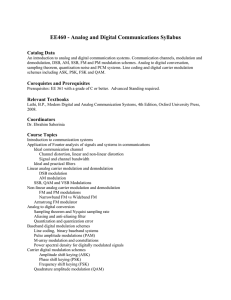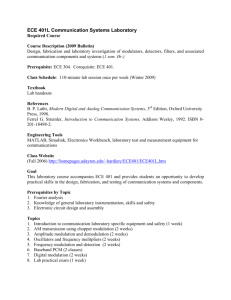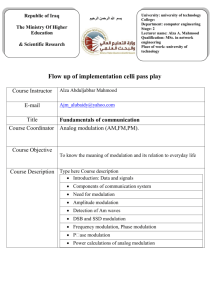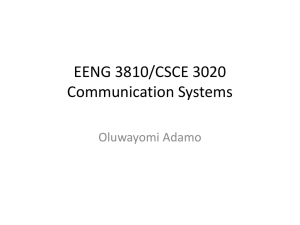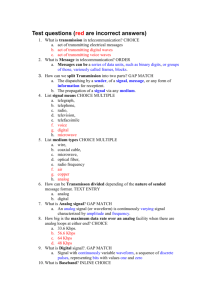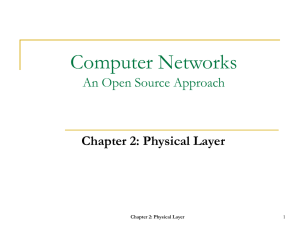ENPM601 Analog and Digital Communication Systems Syllabus
advertisement
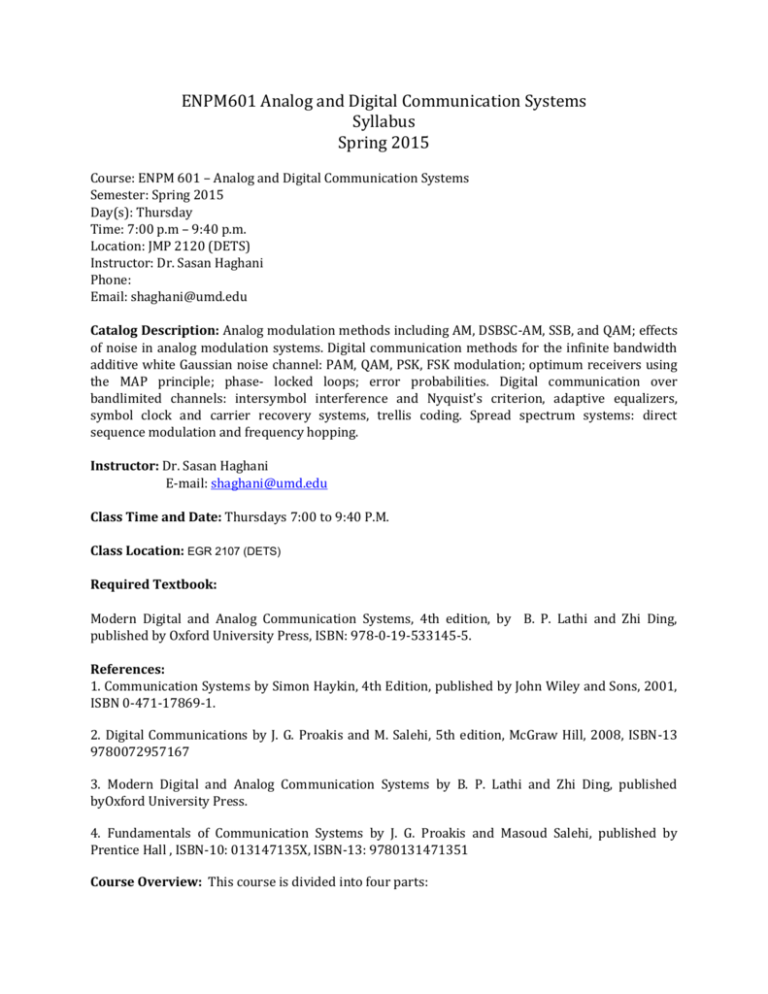
ENPM601 Analog and Digital Communication Systems Syllabus Spring 2015 Course: ENPM 601 – Analog and Digital Communication Systems Semester: Spring 2015 Day(s): Thursday Time: 7:00 p.m – 9:40 p.m. Location: JMP 2120 (DETS) Instructor: Dr. Sasan Haghani Phone: Email: shaghani@umd.edu Catalog Description: Analog modulation methods including AM, DSBSC-AM, SSB, and QAM; effects of noise in analog modulation systems. Digital communication methods for the infinite bandwidth additive white Gaussian noise channel: PAM, QAM, PSK, FSK modulation; optimum receivers using the MAP principle; phase- locked loops; error probabilities. Digital communication over bandlimited channels: intersymbol interference and Nyquist's criterion, adaptive equalizers, symbol clock and carrier recovery systems, trellis coding. Spread spectrum systems: direct sequence modulation and frequency hopping. Instructor: Dr. Sasan Haghani E-mail: shaghani@umd.edu Class Time and Date: Thursdays 7:00 to 9:40 P.M. Class Location: EGR 2107 (DETS) Required Textbook: Modern Digital and Analog Communication Systems, 4th edition, by B. P. Lathi and Zhi Ding, published by Oxford University Press, ISBN: 978-0-19-533145-5. References: 1. Communication Systems by Simon Haykin, 4th Edition, published by John Wiley and Sons, 2001, ISBN 0-471-17869-1. 2. Digital Communications by J. G. Proakis and M. Salehi, 5th edition, McGraw Hill, 2008, ISBN-13 9780072957167 3. Modern Digital and Analog Communication Systems by B. P. Lathi and Zhi Ding, published byOxford University Press. 4. Fundamentals of Communication Systems by J. G. Proakis and Masoud Salehi, published by Prentice Hall , ISBN-10: 013147135X, ISBN-13: 9780131471351 Course Overview: This course is divided into four parts: In the first part, we begin with an overview of communication systems. A quick review Fourier Transforms will be given followed by a review of stationary and ergodic random processes. Power spectral density and complex-envelope representation of signals will be covered. Analog communication techniques including amplitude modulation (AM) and frequency modulation (FM) will be covered. The effect of noise of the performance of analog communication systems will be reviewed. In the second part, the transition from analog to digital communication systems will be discussed first. The sampling theorem and the effect of quantization will be discussed. Digital communications for both bandwidth-limited and power-limited AWGN channels will be discussed. Modulation techniques such as BPSK, QPSK, MPSK, MQAM , MSK and GMSK will be covered. In the third part, we cover the performance of communication systems in the presence of ISI. ZF, DFE and adaptive equalization techniques will be discussed. Spread Spectrum communication systems will be introduced and Multiple Access techniques (FDMA, TDMA and CDMA) will be described that allow multiple users to share communications resources. The performance of communication systems over fading channels will be covered. Time permitting, multiple-input multiple outpur (MIMO) communication systems will be introduced. The fourth part of the course will consider the information theoretic bounds for source coding and channel capacity. Huffman and Lempel-Ziv source coding will be covered. Error-control coding for power-limited channels will be covered with examples of commonly used block and convolutional codes. Tentative Schedule: Introduction, Overview, Communications System Elements, Service Requirements. Review of Random Processes, Fourier Transform, Signals and Systems and Hilbert Transform. Continuous Wave (Analog) Modulation, AM and FM Modulation and Demodulation, Noise and Impairments, Examples of Voice and TV Transmission. Nyquist Sampling Theorem, Information Sources, Pulse Code Modulation (PCM), Delta Modulation, Quantizing Noise, Digitization of Video and MPEG. Baseband Pulse Modulation, Digital Transmission over the AWGN Channel, Modulation for Power- or Bandwidth-Limited Channels, Matched Filters, Likelihood Receivers, PAM for Bandwidth-Limited Channels. Passband Digital Transmission via Carrier Modulation, BPSK, QPSK, MSK, GMSK, QAM, Power Density Spectra and Probability of Bit Error, Nyquist Filtering, Demodulator Implementation, Sources of Impairment and Bit Error Rate (BER). The 8-VSB digital TV transmission format. Mid-Term Exam Performance of Communication systems in presence of ISI. ZF, DFE and adaptive equalization. Multi-User Communications, Multiple Access Techniques, FDMA, TDMA, CDMA, Spread Spectrum Communications, Dynamic Spectrum Access, Communication over fading channels. Satellite Communications Applications, System Elements, Performance Predictions, Link Budget Examples. Fundamental Limits in Information Theory, Source Coding, Information Capacity, Data Compression. Error Control Coding for Power Limited Channels, Linear Block Codes, Cyclic Codes, Convolutional Coding/Viterbi Decoding. Final Exam Code of Academic Integrity: "The University of Maryland, College Park has a nationally recognized Code of Academic Integrity, administered by the Student Honor Council. This Code sets standards for academic integrity at Maryland for all undergraduate and graduate students. As a student you are responsible for upholding these standards for this course. It is very important for you to be aware of the consequences of cheating, fabrication, facilitation, and plagiarism. For more information on the Code of Academic Integrity of the Student Honor Council, please visit Student Honor Council, Honor Pledge."

